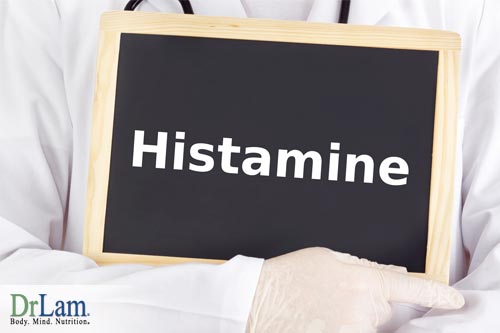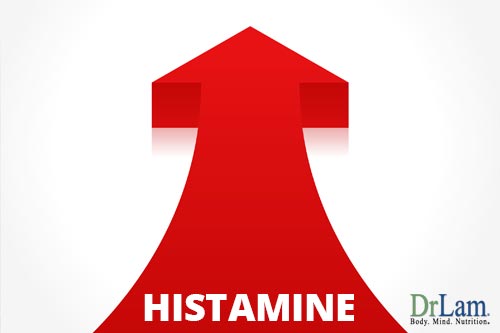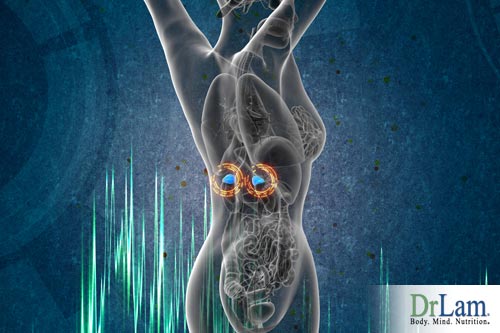 Histamines are compounds found in various parts of the body. From the brain to the gut, histamine has a variety of actions. It is both a neurotransmitter as well as an immunomodulator. Depending on where it is found in the body, and what receptor it interacts with, histamine can elicit a multitude of reactions. There are four types of receptors, numbered H1 to H4. Each are found in different parts of the body and have distinctly different effects on the body when activated.
Histamines are compounds found in various parts of the body. From the brain to the gut, histamine has a variety of actions. It is both a neurotransmitter as well as an immunomodulator. Depending on where it is found in the body, and what receptor it interacts with, histamine can elicit a multitude of reactions. There are four types of receptors, numbered H1 to H4. Each are found in different parts of the body and have distinctly different effects on the body when activated.
H1 receptors are found in the central nervous system (CNS) as well as the peripheral nervous system (PNS). When activated in the CNS they produce a number of effects. One such effect is the firing of hypothalamic neurons that are active when we are awake. This is why anti-histamine drugs such as Benadryl can cause drowsiness by blocking this receptor. Histamine’s effect on the PNS H1 receptor is completely different. These receptors are found on smooth muscles and on inside blood vessels. This is the receptor that gets activated when you have an allergic reaction. Histamines bind to the H1 receptor in the blood vessels to cause vasodilation and increase permeability. This is what causes hives as well as the redness and swelling seen in inflammation. It also causes smooth muscle contraction in your bronchial muscles, leading to difficulty breathing, asthma, and potentially life-threatening anaphylaxis.
H2 receptors are mainly found in the gut. They are located on parietal cells, which are responsible for the secretion of gastric acid. An increase in histamines will subsequently lead to an increase in gastric acid secretion. This is why H2-antagonist drugs such as Zantac were developed. These drugs are used to decrease the release of gastric acid and help with conditions such as peptic ulcer disease and gastro-esophageal reflux disease (GERD) as well as the prevention of stress ulcers.
H3 receptors are unique in that they are inhibitory receptors. Mostly found in the CNS, they are part of a negative feedback loop that inhibits histamine synthesis and release. They have also been shown to inhibit other neurotransmitters such as dopamine, acetylcholine, GABA and serotonin. Blocking the H3 receptor in animals has been shown to increase anxiety. When the H3 receptor is blocked, histamine synthesis and release are no longer inhibited, causing an increase in histamine. Thus, histamines are thought to be related to anxiety. Although no drug has been developed and approved specifically to target the H3 receptor, many drugs still act on the receptor secondarily and produce anxiety or depression as a side effect. Due to the H3 receptor’s effect on other neurotransmitters, it has also been implicated in other mental disorders such as attention deficit hyperactivity disorder, Alzheimer’s disease, and even schizophrenia.
The fourth and final histamine receptor, H4, is found primarily in the bone marrow and on basophils. It is responsible for releasing neutrophils into the bloodstream from the bone marrow as well as mast cell chemotaxis. Mast cells are immune cells that are loaded with heparin and histamine. They play a major role in allergies and anaphylaxis. So in a chain reaction, H4 receptor modulation and chemotaxis leads to Mast cell aggregation, which upon releasing amplified amounts of histamines in a process known as mast cell degranulation, can eventually result in chronic inflammation and inflammatory disorders such as allergies or asthma.
Knowing where histamines are and what they do is half the battle. How do these chemical reactions translate to the real world though? Histamines are toxic molecules. It has a long list of negative effects on the body if left unchecked.
 While histamine is a natural compound that is produced by your body and manifested at normal levels automatically elevated levels can occur. Antihistamines are common drugs prescribed by doctors and even available over the counter. Antihistamines have common side effects such as drowsiness, upset stomach, difficulty urinating, nervousness, dry mouth, and dry nose. They are typically used in an acute setting when requiring immediate symptom releases such as allergic reactions and hay fever. This is fine as the receptor gets blocked for a short duration, but everything goes back to baseline soon enough. However, when taking antihistamines chronically, the body never gets back to baseline. Antihistamine drugs do not stop the production of histamine. They occupy the receptor so that histamine cannot act on it. Histamine continues to be produced in increasing amounts as the body recognizes that histamine is not functioning, as it should be. The body slowly builds a tolerance to antihistamine medication until the medicine no longer works. When antihistamines are discontinued, a rebound effect occurs and the body is flooded with histamine. The body will continue to release high levels of histamine because that is what it is used to doing. All the negative effects of histamines such as fatigue, anxiety, brain fog, and palpitations will be felt as the body is continuously overloaded with histamine.
While histamine is a natural compound that is produced by your body and manifested at normal levels automatically elevated levels can occur. Antihistamines are common drugs prescribed by doctors and even available over the counter. Antihistamines have common side effects such as drowsiness, upset stomach, difficulty urinating, nervousness, dry mouth, and dry nose. They are typically used in an acute setting when requiring immediate symptom releases such as allergic reactions and hay fever. This is fine as the receptor gets blocked for a short duration, but everything goes back to baseline soon enough. However, when taking antihistamines chronically, the body never gets back to baseline. Antihistamine drugs do not stop the production of histamine. They occupy the receptor so that histamine cannot act on it. Histamine continues to be produced in increasing amounts as the body recognizes that histamine is not functioning, as it should be. The body slowly builds a tolerance to antihistamine medication until the medicine no longer works. When antihistamines are discontinued, a rebound effect occurs and the body is flooded with histamine. The body will continue to release high levels of histamine because that is what it is used to doing. All the negative effects of histamines such as fatigue, anxiety, brain fog, and palpitations will be felt as the body is continuously overloaded with histamine.
 Another way that inadvertently increases histamine levels is by eating foods high in histamine. Histamine is usually metabolized in the intestines and liver. However, some individuals may have low levels of the required enzymes to metabolize histamine and thus have increased circulating histamine. Histamine is typically found in foods that have been fermented or highly processed. Fermented cheeses such as cheddar and Gouda are high in histamine. Other dairy products such as yogurt and buttermilk also contain elevated histamine amounts. Salami, pepperoni, sausage, and other processed meats are also high in histamine. Vegetables such as tomatoes, spinach, and eggplant contain increased histamine compared to other vegetables. Berries have been shown to be high in benzoates, which release histamine. Spices such as cinnamon, cloves, and nutmeg also contain benzoate and release histamine when ingested. These are usually not an issue because the body metabolizes them automatically without a problem.
Another way that inadvertently increases histamine levels is by eating foods high in histamine. Histamine is usually metabolized in the intestines and liver. However, some individuals may have low levels of the required enzymes to metabolize histamine and thus have increased circulating histamine. Histamine is typically found in foods that have been fermented or highly processed. Fermented cheeses such as cheddar and Gouda are high in histamine. Other dairy products such as yogurt and buttermilk also contain elevated histamine amounts. Salami, pepperoni, sausage, and other processed meats are also high in histamine. Vegetables such as tomatoes, spinach, and eggplant contain increased histamine compared to other vegetables. Berries have been shown to be high in benzoates, which release histamine. Spices such as cinnamon, cloves, and nutmeg also contain benzoate and release histamine when ingested. These are usually not an issue because the body metabolizes them automatically without a problem.
Excessive histamine can wreck havoc in the body. Starting with the brain, histamine has the ability to inhibit almost every neurotransmitter and is a neurotransmitter in itself. Any unbalance in the chemical makeup of your brain is bound to cause unwanted effects such as brain fog, fatigue, and anxiety. It is also why histamine has been implicated in several major psychiatric disorders. Along with psychiatric disorders, histamine is also involved in the sleeping cycle, mainly stimulating the body to stay awake. This can only worsen the symptoms manifesting in the brain. At the cardiovascular system, with histamine being a vasodilator and opening up the vessels in the body, the heart will have to pump harder and faster to maintain the same blood flow. This can lead to tachycardia, heart palpitations and low blood pressure. Heart palpitations combined with increased anxiety can often lead to panic attacks too. Unchecked histamine can also lead to increased gastric acid secretions in the gut, contributing to irritable bowel syndrome and gastric ulcers.
On top of all these conditions, histamine actively plays a role in inflammation and the allergic reaction, having high histamine levels in your body is similar to being in a chronic inflammatory or allergic state. One can experience itching, nasal congestion, asthma, red eyes, hives, and even angioedema. These symptoms are largely modulated by the adrenal glands. We will go into these in more detail later.
 Elevated histamine levels do not bode well for the adrenal glands. Histamine is an inflammatory molecule. Cortisol, released by the adrenal glands, is an anti-inflammatory compound. One can imagine the contrasting battle these two molecules go through on a daily basis. Any unnecessary rise in histamine levels only serves to burden the adrenal glands. Adrenal Fatigue Syndrome (AFS), especially those in advanced stages, invariably are overloaded with histamine internally without sufficient cortisol to counter its effect. It comes as no surprise that many are in a generalized inflammatory state with many nonspecific but bothersome symptoms of discomfort.
Elevated histamine levels do not bode well for the adrenal glands. Histamine is an inflammatory molecule. Cortisol, released by the adrenal glands, is an anti-inflammatory compound. One can imagine the contrasting battle these two molecules go through on a daily basis. Any unnecessary rise in histamine levels only serves to burden the adrenal glands. Adrenal Fatigue Syndrome (AFS), especially those in advanced stages, invariably are overloaded with histamine internally without sufficient cortisol to counter its effect. It comes as no surprise that many are in a generalized inflammatory state with many nonspecific but bothersome symptoms of discomfort.
As a result of inflammation, many suffer from migrating pain of unknown origin, especially in the muscles and joints. There is no deformity in the joints, and the discomfort can come and go at will without a set pattern. Doctors are usually at a loss after a normal blood test without significant signs of autoimmune disease. Pain medications are usually prescribed but seldom necessary as the discomfort is generally nagging in nature and not very severe.
Sometimes pain can be in the lower back area surrounding the kidneys. There is no significant physical finding. Visits to family doctors are made and bladder and urinary track infection workups are usually negative. Abdominal CT scans are normal. Many will report a dull ache or a sensation of feeling heat in the area of the adrenal glands that is worsened under stress or when energy levels are low, or when certain types of food are consumed. There is no specific point of tenderness on palpation. The sufferer is usually told that it is all in their head.
Food sensitivity is common when histamine levels rise beyond what the body can handle. Intake of watermelon, for example, can lead to skin itchiness in distant parts of the body such as the ear lobes. Dairy products can lead to excessive nasal drip that can be postnasal in nature. Sufferers generally report a sense of congestion during the day, and wake up in the morning with a cough. Headaches of unknown origin, excessive bloating, and stomach pain are all common presentations.
 Increased sensitivity to seasonal allergens is also a common finding. Due to intrinsic high histamine levels within, the threshold for external allergens to trigger inflammation is reduced, especially from pollen and grass during the spring. Most sufferers of AFS will find themselves highly sensitive to such external allergens in addition to heat intolerance when outdoors. Runny nose, sense of itchiness at the throat, and sniffling are common presenting complaints. Steroidal nasal sprays and anti-histamine medications are prescribed frequently for what appears to be classic signs of allergic rhinitis. Without understanding the root cause and trigger, this medication only acts to reduce symptoms and bring temporary relief. With prolonged use, tolerance and dependence develop. Those with marginal or mild adrenal fatigue will find their condition worsens over time, as the adrenals will slow down production of steroids due to the ample external supply as the feedback loop is disrupted. Withdrawal and rebound symptoms may arise if the medications are stopped abruptly.
Increased sensitivity to seasonal allergens is also a common finding. Due to intrinsic high histamine levels within, the threshold for external allergens to trigger inflammation is reduced, especially from pollen and grass during the spring. Most sufferers of AFS will find themselves highly sensitive to such external allergens in addition to heat intolerance when outdoors. Runny nose, sense of itchiness at the throat, and sniffling are common presenting complaints. Steroidal nasal sprays and anti-histamine medications are prescribed frequently for what appears to be classic signs of allergic rhinitis. Without understanding the root cause and trigger, this medication only acts to reduce symptoms and bring temporary relief. With prolonged use, tolerance and dependence develop. Those with marginal or mild adrenal fatigue will find their condition worsens over time, as the adrenals will slow down production of steroids due to the ample external supply as the feedback loop is disrupted. Withdrawal and rebound symptoms may arise if the medications are stopped abruptly.
Reducing internal histamine load should be part of a total recovery program in AFS. The key is to first recognize that histamine does play an important role in worsening adrenal fatigue. The astute clinician should be on alert for symptoms mentioned above as clues for further investigation. Normal laboratory finds are actually supportive of the investigative process. The key rests with a detailed history conducted carefully by an experienced clinician. Nature has provided us with a battery of compounds with antihistamine effects. They are best used in a nutritional cocktail for optimal results.
Hives can be due to many reasons, the most common of which is some form of sensitivity that leads to excessive histamine release. This can be associated with AFS.
You could have allergies from the environment, chemical or food. Keep a journal and find out what is causing your allergies. Allerdim has quercetin that is a natural antihistamine. Allergic (food or chemicals or sensitivities) and asthma reactions usually have strong adrenal components. Many allergies involve the release of histamine and other pro-inflammatory substances. The body's response is to produce cortisol, a strong anti-inflammatory hormone. The weaker the adrenals, the higher the frequency of allergies. This is because the more histamine is released, the more cortisol it takes to control the inflammatory response and the harder the adrenals have to work to produce more cortisol. When the adrenals are eventually exhausted, cortisol output is compromised, allowing unopposed histamine to inflame the bodily tissues more. This vicious circle can lead to progressively deepening adrenal exhaustion and producing more severe allergic reactions.